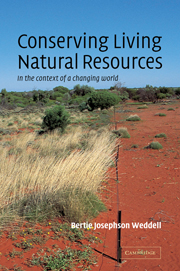Book contents
- Frontmatter
- Contents
- Preface
- Introduction: Balance and flux
- Methodology: Getting the information we need to manage living natural resources
- Part I Management to maximize production of featured species – a utilitarian approach to conservation
- Part II Protection and restoration of populations and habitats – a preservationist approach to conservation
- Part III Management to maintain processes and structures – a sustainable-ecosystem approach to conservation
- 11 Historical context – pressures to move beyond protection of species and reserves
- 12 Central concepts – the flux of nature
- 13 Techniques – conserving processes and contexts
- 14 Techniques – including people in the conservation process
- Postscript
- Appendix: Scientific names of organisms mentioned in the text
- Index
14 - Techniques – including people in the conservation process
Published online by Cambridge University Press: 05 June 2012
- Frontmatter
- Contents
- Preface
- Introduction: Balance and flux
- Methodology: Getting the information we need to manage living natural resources
- Part I Management to maximize production of featured species – a utilitarian approach to conservation
- Part II Protection and restoration of populations and habitats – a preservationist approach to conservation
- Part III Management to maintain processes and structures – a sustainable-ecosystem approach to conservation
- 11 Historical context – pressures to move beyond protection of species and reserves
- 12 Central concepts – the flux of nature
- 13 Techniques – conserving processes and contexts
- 14 Techniques – including people in the conservation process
- Postscript
- Appendix: Scientific names of organisms mentioned in the text
- Index
Summary
Euroamerican traditions of utilitarian and preservationist resource management both seek to manage people in a human-dominated landscape within which parcels are set off as “natural.” We have seen that resource managers are becoming increasingly aware of political, ecological, and ethical reasons for including the activities of people explicitly in management plans, however. A number of innovative strategies for doing this have emerged within the past two decades.
In Chapter 10 we examined one type of economic conservation incentive, the debt-for-nature swap. In such an arrangement, parties from the developed world pay a developing country (by getting its debt reduced) to protect lands from exploitation. This strategy of having outsiders with a stake in resource preservation pay to support limits on resource use has been successful in some instances, but long-term resource conservation also requires the integration of resource use and conservation.
The examples described in this chapter interweave three themes. First, traditional modes of resource use as well as novel forms of exploitation can, under some circumstances, be carried on within areas that are considered preserves. Second, resource uses outside preserves should support, rather than undermine, ecosystem conservation. Third, resource conservation must be linked to tangible benefits for local people. This is especially important if the people who benefit from conservation live far from the place where that conservation takes place. Before looking at these themes in more detail, however, it is necessary to revisit the concept of sustainable use.
- Type
- Chapter
- Information
- Conserving Living Natural ResourcesIn the Context of a Changing World, pp. 370 - 395Publisher: Cambridge University PressPrint publication year: 2002



